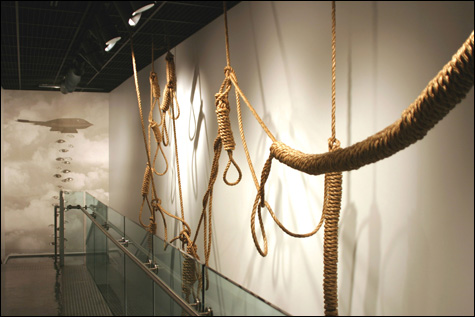
NATION BUILDING: Finley’s outrage and despair feel prefab. |
Karen Finley sat at the edge of the stage of Emerson College’s Cutler Majestic Theatre last week and spoke about a woman who got off on war: “During the Gulf War, she glued herself to CNN . . . pressed her wet cunt to the screen . . . ”In Finley’s monologue, the character picks up Vietnam vets and brings them home to watch Vietnam films with her, aroused by their bad memories. “And it turned her on to no end,” Finley recited, “because in feeling the man’s pain and vulnerability, her own life made some goddamn sense, her femininity, her womanness, because she was with a man who would die for her.”
It was a shot across the bow from one of America’s most notorious art provocateurs. The New Yorker rocketed to national attention when her monologues — a potpourri of pathos, sex, lefty feminist politics, and smearing food on her naked self — landed her smack in the middle of the Culture Wars. She was about to win a grant from the National Endowment for the Arts in 1990 when conservatives attacked the government agency and her, getting the grant veto’d. She and three other NEA recipients whose work had been declared “indecent” sued for reinstatement; initially they won, but in 1998 the Supreme Court ruled against them.
Finley’s one-night Boston performance on March 19 and a related exhibition at Emerson’s Huret and Spector Gallery up through April 18 show where she’s gone since. It’s a dull place.
In her ink drawings The Dreams of Laura Bush (2006–present), she imagines the first lady dreaming of Jodie Foster rounding up Iraqi insurgents. Other episodes: “Saddam’s last request was to finger Laura Bush”; George Bush allowing James Brown to be cloned despite his opposition to cloning (he “said he was a clone of his father . . . and that is why he was against cloning”), and “Cheney and James Baker tried to wear the same pair of boots. I didn’t tell them that the boots were mine and not George’s.”
Elsewhere Finley focuses on Condoleezza Rice. A couple of pieces address the Ku Klux Klan’s notorious bombing of the Sixteenth Street Baptist Church in Birmingham, Alabama, in 1963. Rice grew up there, and she knew some of the girls who were killed in the blast. Dressed To Kill (2006), an oil painting of ladies’ boots, refers to Rice’s shopping trip to New York in September 2005 while New Orleans drowned. Another piece depicts Rice’s eyes dropping from the belly of a stealth bomber.
Deathwatch (2007) turns doodles of Saddam Hussein’s hanging into wallpaper. Nation Building (2007) is a web of nooses hanging from the gallery ceiling. Business As Usual (2007) is two computers printing out lists of Iraqi and American dead of the Iraq war. The unending tally is a sad memorial — but Finley’s outrage and despair feel prefab. What always charged her work was the way she linked politics with the strange, untamed, uncomfortable desires lurking inside our pop culture. But four years into the War in Iraq, her critiques aren’t shocking, they’re old news. Besides, she’s a lousy drawer — these pieces feel like shoddy studies to be more fully realized later. (The Laura Bush dream drawings relate to a piece by the same name that she performed at Emerson on March 19; last year she published George and Martha, a graphic-novel satire about a tryst between George W. and Martha Stewart.) Her critiques are safe and shallow, just clowning, name calling, and adolescent caricatures. She doesn’t engage the ideas or the policies of her targets.
The Laura Bush piece reminds me of American Repertory Theatre’s staged reading of Tony Kushner’s Only We Who Guard the Mystery Will Be Unhappy in 2004. Both works portray Laura Bush as a dope, but they also imagine her as the guilty conscience inside the White House, the one Bushie troubled by the administration’s disasters and its callousness. It’s an understandable desire, and a useful dramatic strategy, but why should our top stand-by-your-man conservative lady not be as confident of the righteousness of the administration’s actions as anyone else in the White House?
The Culture Wars, meanwhile, have moved on to stem cells, cloning, and biotechnology — the subjects of “It’s Alive!” at Montserrat College of Art. From Bostonians Jennifer Hall and Blyth Hazen we have the sculpture Acupuncture for Temporal Fruit, a robot that jabs needles into a shriveling tomato under a bell jar; the pace picks up as you move in for a closer look. Hunter O’Reilly of Chicago presents Petri dishes filled with glow-in-the-dark bacteria. Brown butterflies by Bostonian Brian Burkhardt cling to a corner of the gallery. I gather they’re intended as a warning about the potential use of bio-engineered critters for surveillance, but I’m not sure how we’re supposed to connect the dots based on just the sculptures.